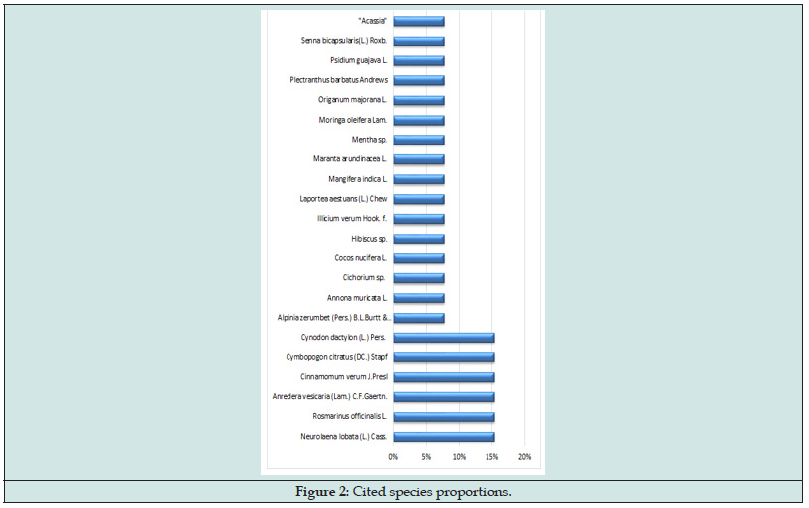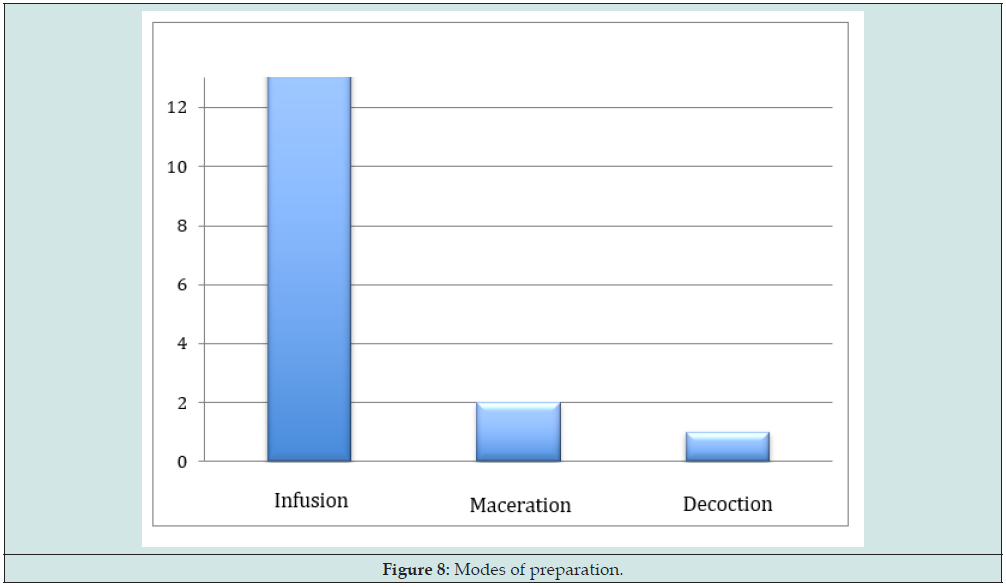
Lupine Publishers Group
Lupine Publishers
Menu
ISSN: 2638-6070
Mini Review(ISSN: 2638-6070) 
Ethnopharmacological Survey on the Role of Medicinal Plants in Guadeloupe from Infancy to Adolescence
Volume 4 - Issue 3Kévin Boisdur1, Marie-Ange Mitaï1, Titouan Gaddini1, Garick Bibian1, Petra Couderc-Murillo1, Muriel Sylvestre1 and Gerardo Cebrian-Torrejon1,2 *
- 1Department of Chemistry, University of the French West Indies, France
- 2C3MAG, Université des Antilles, France
Received: July 20, 2022 Published: August 9, 2022
*Corresponding author:Gerardo Cebrian Torrejon, COVACHIM-M2E Laboratory EA 3592, University of the French West Indies, Fouillole Campus, UFR SEN, Department of Chemistry, Pointe-à-Pitre Cedex, Guadeloupe, France
DOI: 10.32474/SJFN.2022.04.000189
Abstract
Nowadays, it is easy and almost automatic to turn to industrial (commercial) drugs because they are easily accessible. However, we must not forget the great diversity of tropical medicinal plants that is available to everyone. To illustrate this aspect, we surveyed the students of the University of the Antilles (Campus de Fouillole, Guadeloupe) about their knowledge about the use of medicinal plants transmitted by their ancestors and whether it has lasted throughout the generations. The objective of this research is twofold, on the one hand, to value the local culture and flora and, on the other, to check the position of young people regarding the use of medicinal plants in their day-to-day life.
Keywords:Traditional medicine; Ethnopharmacology; Caribbean; Guadeloupe
Introduction
Guadeloupe is an archipelago located in the French Lesser Antilles, with a total area of 1,628 km2. Bordered to the west by the Caribbean Sea and to the east by the Atlantic Ocean, Guadeloupe main islands are: Grande-Terre and Basse-Terre cut by an arm of the sea called Rivière salée, Marie-Galante, Les Saintes (Terre-de- Haut and Terre-de-bas) and the Désirade. The climate is tropical with two seasons (dry and wet). The archipelago has a population density of 240 inhabitants/km2 for a population estimated at about 375,000 inhabitants in 2021 according to the latest census (INSEE).
Guadeloupe has a huge cultural and ethnic diversity (including, among others, Afro-Caribbeans, Europeans, Amerindians and Indians), so traditional medicines vary and so does the use of plants. The population of the Caribbean basin has a tradition of using herbal remedies to maintain general health and well-being, or to treat or prevent diseases [1-4].This traditional medicine takes advantage of the extraordinary biodiversity advantages of the Caribbean islands, classified as one of the 34 global biodiversity hotspots [5]. Our objective is to conduct a first exploration of the role of medicinal plants from childhood to adolescence on the Fouillole campus (University of Antilles). This preliminary assessment of the knowledge of the younger generation also allows us to understand if the knowledge about medicinal plants endures and is transmitted and if there is a revival of interest in medicinal plants and if new practices are carried out.
Methods
The applied protocol consisted of conducting a standard ethnopharmacological survey [4]. The first stage of the ethnopharmacological protocol is the field surveys, which are characterized by individual and structured interviews in which open and closed questions are asked through a questionnaire. Surveys can be of various types: through interviews (in this case) or by filling out questionnaires in person or by other means (computer, telephone, etc.).
The present survey was conducted at the University of the Antilles with students at the Fouillole campus (13 people in total). Respondents were selected randomly (trying not to have any demographic, ethnic or university education bias), simply taking into account the openness or availability of the interviewees. We collected qualitative and quantitative data that allow us a first global vision on our topic: the role of medicinal plants from childhood to adolescence. Therefore, we searched for the names of several plants used for general health (birth, childhood, schooling, examinations, etc.) and also for their well-being (headaches, digestive disorders, purging, refreshment, baths, etc.). In this way we cover the use of plants to heal health problems and the use of plants for nonphysical ailments.
Results and Discussion
The first result (Table 1) refers to the uses of the species identified as useful from childhood to adolescence. Figure 1 shows that plants of the Asteraceae, Poaceae and Lamiaceae families were most frequently cited by students on the Fouillole campus [6] and Table 1 presents their vernacular names in French and Creole. Indeed, in the Asteraceae family, the following species were the most frequently cited (Figure 2): “zèb à pic” (Neurolaena lobata (L.) Cass.) and chicory or “chikoré” (Cichorium sp.). Perhaps this popularity is due to the formulation of the Virapic® remedy (Phytobokaz® Laboratoy), which is known for its pharmacological properties [7]. Poaceae include citronella, “ti kann” or “sitwonnèl” (Cymbopogon citratus (DC.) Stapf), and “chiendent” (Cynodon dactylon (L.) Pers.). Two herbaceous plants with proven virtues that are also widely used on the island of Martinique [8]. And for the Lamiaceae, the “doliprann” (Plectranthus barbatus Andrews) and Rosemary or “romaren”(Rosmarinus officinalis L.). Two nonnative/ introduced species, which may illustrate the appropriation of phytotherapeutic knowledge from elsewhere, such as their use as anti-inflammatories in metropolitan France as well as in other Caribbean islands.
The second result is an analysis of the target audience, the students, we worked with a small staff of 13 people. They averaged 22 years of age and were almost equally represented, with seven young women and six young men (Figures 3 & 4). Following our survey, we found in particular that the transmission is mostly within family (93%) %) compared to outsiders (6%) (Figure 5). Maternal ancestry (68%) transmits most of the knowledge about medicinal plants compared to paternal lineage (16%), which is consistent with previous studies by Picking and collaborators [9]. As with the work done by Drane, in Martinique, where they also show that with the passage of time “transmission is lost” [10], this evidence was also highlighted according to the participants of the present survey. However, despite this trend of loss of knowledge about medicinal plants, the young people interviewed showed a desire to continue acquiring knowledge about the use of medicinal plants (Authors’ observation).
Most of the students mainly cited the use of plant leaves (11), as recorded in an ethnopharmacological study conducted on the islands of Les Saintes [4] (part of the Guadeloupe archipelago). This would imply that these young people believe that the active ingredients are mainly found in the leaves (Figure 5). However, we know that leaves are an important cultural resource in Caribbean society [11]. But perhaps also that transmission has been restricted to formulations based on the individual leaves of the plant, supporting a loss of diversity of knowledge related to the traditional uses of other parts of plants (flowers, roots, fruits, etc.).
The uses of plants, as illustrated in Figure 6, are diverse. The most cited are for indigestion (5), headaches (4) and the “cleaning” of the organism (4), however the use for the treatment of psychological problems (non-physical, spiritual or other ailments) was also recorded (Figure 7). Infusion is by far the most used preparation (13), commonly called tea, tisane or “tizann” (Figure 8). As a result, plants are used more by mouth (20) than by dermal application (1) or bath (3) (Figure 9). These same observations can be found in the book “Les savoirs naturalistes populaires de Guadeloupe” [12]. It is worth noting that posology is a very tricky and potentially dangerous point, since doses are not objectively quantified, regardless of the student interviewed (Figure 10). Respondents use for their preparations “a handful”, “3 leaves” or “1 tablespoon”. In addition, most of the students remain cautious with respect to the doses of the plants [13-15].
Conclusion
As a conclusion of this study we observed that :
a) Generally the transmission of knowledge is familiar and comes from the mother’s side.
b) The three main families most cited are: Asteraceae, Poaceae and Lamiaceae.
c) The most frequent applications are: Digestive problems, headaches, depurative and dermatological problems. The survey also reports the use of plants for non-physical ailments, but with a lower incidence.
d) The most used part of the plant is the leaf prepared as an infusion (oral administration).
e) Dosage is approximate.
Acknowledgments
First of all, we would like to thank the “Région Guadeloupe” and the “Communauté d’agglomération du Sud Basse-Terre (CASBT)” for funding the project “Jardin Créole Médicinal”. As well as to the Collectivité Territoriale de Martinique (CTM) for the PhD scholarship of Petra COUDERC-MURILLO. And the European Regional Cooperation Fund Interreg Caribbean V (Project CARIBPHLORE) for the scholarship of Garick BIBIAN.
Our sincere appreciation goes to Danielle CELESTINE-MYRTILMARLIN for allowing us to integrate the research project “Apprentis chercheurs” of the program “l’Arbre dês connaissances” and to live this fabulous experience. Finally, we would like to thank Gerardo CEBRIÁN PÉREZ and Lionel ROBINEAU for their attentive reading and valuable comments.
References
- Robineau L, Propato M, Tramil (2007) Caribbean herbal pharmacopoeia. Santo Domingo (Dominican Republic: TRAMIL.
- Bahall M, Edwards M (2015) Perceptions of complementary and alternative medicine among cardiac patients in South Trinidad: A qualitative study. BMC Complement. Altern Med 15 :99-109.
- Picking D, Younger N, Mitchell S, Delgoda R (2011) The prevalence of herbal medicine home use and concomitant use with pharmaceutical medicines in Jamaica. Journal of Ethnopharmacology 137(1): 305-311.
- Boulogne I, Germosén Robineau L, Ozier Lafontaine H, Fleury M, Loranger Merciris G (2011) TRAMIL ethnopharmalogical survey in Les Saintes (Guadeloupe, French West Indies): A comparative study. J Ethnopharmacol 133(3): 1039-1050.
- Hobohm C (2003) Characterization and ranking of biodiversity hotspots: Centres of species richness and endemism. Biodiversity & Conservation 12: 279-287.
- Fournet J (2002) Flore illustrée des phanérogames de Guadeloupe et de Martinique. Gondwana edition, France.
- Gracioso JS, Hiruma Lima CA, Souza Brito ARM (2000) Antiulcerogenic effect of a hydroalcoholic extract and its organic fractions of Neurolaena lobata (L.) R.BR. Phytomedicine 7(4): 283-289.
- Joseph P (2017) The diversity of the Useful Flora of the Lesser Antilles: The example of the medicinal plants of Martinique. Wulfenia 24: 101-130.
- Picking D, Delgoda R, Younger N, Germosén Robineau L, Boulogne I, et al. (2015) TRAMIL ethnomedicinal survey in Jamaica. Journal of Ethnopharmacology 169: 314-327.
- Drane E, Feliot Rippeault M, Smith Ravin J, François Haugrin O (2018) Ethnobotanical Study in Martinique of the Species Behind the Local Plant Name Bwa Kaka. Ethnobiology Letters 9(2): 136-149.
- Concy H (2015) The transmission of Creole medicinal heritage: Issues, relevance, and evaluation of traditional knowledge.
- François MD (1985) Popular naturalist knowledge in Guadeloupe: Final report December 85.
- Benoît C (2000) Bodies, gardens, memories anthropology of the body and space in Guadeloupe. Paris: CNRS Edition of the House of Human Sciences.
- Portères R (1961) Ethnobotany: Place - Object - Method - Philosophy. Journal of Traditional Agriculture and Applied Botany 8: 102-109.
- TRAMIL (2014) Caribbean Plant Pharmacopoeia (Third Edition). Pointe a Pitre, Guadeloupe: TRAMIL.

Top Editors
-

Mark E Smith
Bio chemistry
University of Texas Medical Branch, USA -

Lawrence A Presley
Department of Criminal Justice
Liberty University, USA -

Thomas W Miller
Department of Psychiatry
University of Kentucky, USA -

Gjumrakch Aliev
Department of Medicine
Gally International Biomedical Research & Consulting LLC, USA -

Christopher Bryant
Department of Urbanisation and Agricultural
Montreal university, USA -

Robert William Frare
Oral & Maxillofacial Pathology
New York University, USA -

Rudolph Modesto Navari
Gastroenterology and Hepatology
University of Alabama, UK -

Andrew Hague
Department of Medicine
Universities of Bradford, UK -

George Gregory Buttigieg
Maltese College of Obstetrics and Gynaecology, Europe -

Chen-Hsiung Yeh
Oncology
Circulogene Theranostics, England -
.png)
Emilio Bucio-Carrillo
Radiation Chemistry
National University of Mexico, USA -
.jpg)
Casey J Grenier
Analytical Chemistry
Wentworth Institute of Technology, USA -
Hany Atalah
Minimally Invasive Surgery
Mercer University school of Medicine, USA -

Abu-Hussein Muhamad
Pediatric Dentistry
University of Athens , Greece

The annual scholar awards from Lupine Publishers honor a selected number Read More...















